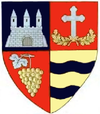|
Chișineu-Criș
Chișineu-Criș (Hungarian: Kisjenő) is a town in Arad County, Crișana, Romania. GeographyThe town is situated on the north-western side of the county, at a 43 km (27 mi) distance from Arad, the county seat. The administrative territory stretches over 119 km2 (46 sq mi) on the Crișul Alb Plateau, on both sides of the river Crișul Alb. The town was formed by merging the villages of Chișineu Mic and Pădureni (Erdőhegy). The town administers one village, Nădab (Nadab). Demographics
In 1910, the town had 2,821 inhabitants: 1,376 (48.8%) spoke Hungarian, 1,355 (48%) spoke Romanian, 49 (1.7%) spoke German. At the 2011 census, it had 7,577 inhabitants, of which 73.5% were Romanians, 19.3% Hungarians, and 6.3% Roma.[3] At the 2021 census, Chișineu-Criș had a population of 7,212.[4] EconomyAlthough the town economy is predominant agricultural, during the last decade the second and third economic sectors had a growing evolution. For most of the tourists Chișineu-Criș is a transit town towards central and Western Europe. The most attractive sightseeing spot of the town is the Crișul Alb River and its banks covered with abundant vegetation. Tourist attractionsThe archaeological discoveries brought to light traces of habitation much older than the documentary attestation of the town. The most important archaeological discoveries that attest the continuity of habitation in the area revealed objects older than 2,500 years in several locations of the town. Also two settlements dated back to the 3rd – 5th and 10th – 11th centuries were found here. Chișineu-Criș was first mentioned as "villa Jeneusol" in the years 1202–1203. Nădab village is attested in a document of 1334 as "Nodob". Natives
ReferencesWikimedia Commons has media related to Chișineu-Criș.
|
||||||||||||||||||||||||||||||||||||||||||||||||||||||||||||||



